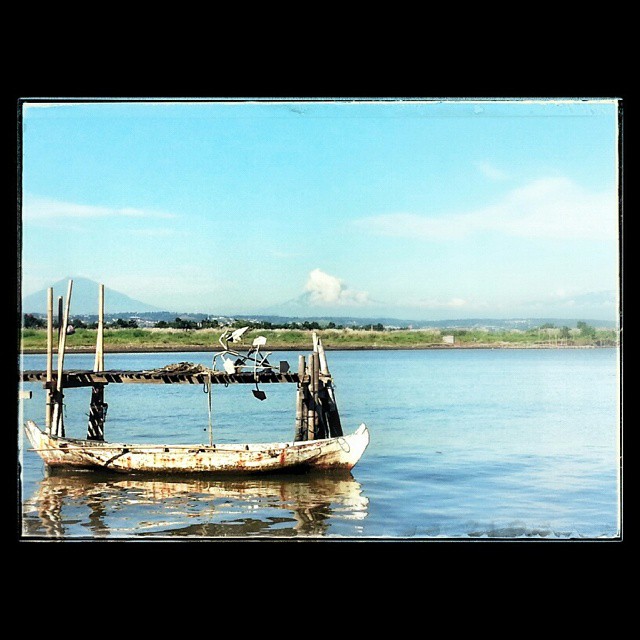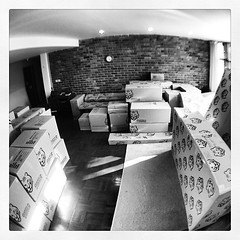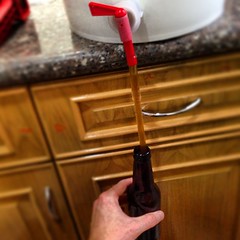East Kalimantan
East Kalimantan (Indonesian: Kalimantan Timur) is a province of Indonesia. Its territory comprises the eastern portion of Borneo. It had a population of about 3.03 million at the 2010 census (within the current boundary), 3.42 million at the 2015 census, and 3.766 million at the 2020 census. The official estimate as at mid 2021 was 3,808,235. Its capital is the city of Samarinda.
East Kalimantan has a total area of and is the second least densely populated province in Kalimantan. The majority of the region shares a maritime border to the east with West Sulawesi and Central Sulawesi; its Cape Mangkalihat separates the Makassar Strait from the Celebes Sea. Its former northernmost region was split off in October 2012 and is now North Kalimantan; meanwhile it still shares land border to the west with West Kalimantan and Central Kalimantan; to its south, East Kalimantan borders South Kalimantan. The province bordered Sabah before the split, but still borders Sarawak.
In December 2012, the existing West Kutai Regency was split in two, with the northwesternmost five districts forming a new Mahakam Ulu Regency. East Kalimantan is now divided into seven regencies and three cities. Isran Noor is the current governor of East Kalimantan and Hadi Mulyadi is its vice governor.
New national capital
The province will host the future capital city of Indonesia that will be built on the border of Kutai Kartanegara and Penajam North Paser regencies. The future capital is due to be named Nusantara, with construction originally projected to start in 2020, and intended to conclude in 2024. However, at a hearing before Committee V of Indonesia's House of Representatives on 9 June 2020, a government representative asserted that the government has not allocated the 2022 budget for the project (for 2022, the ministry proposed a budget worth over 100.46 trillion rupiah - over 7 billion US$ - a steep reduction from the figure of 149.81 trillion rupiah in 2021). Earlier, the National Planning Development Authority had said that the total sum needed to move the capital frm its current location in Jakarta to East Kalimantan province amounted to 486 trillion rupiah, of which 265.2 trillion will be mobilised through the public-private partnership (PPP), 127.3 trillion from private special funds, and 93.5 trillion from the state budget. But the Ministry of Finance has now said that the government has switched its priorities to mitigating the effect of COVID-19. The ministry announced that it has not allocated budget for the new capital project this month .
History
East Kalimantan was once mostly covered by tropical rainforest. In prehistoric times, there was limestone cave called Lubang Jeriji Saléh located in the Sangkulirang-Mangkalihat Karst in the district of Bengalon, East Kutai, believed to contain one of the oldest figurative art in the world. The cave paintings were first spotted in 1994 by the French explorer and the French archaeologist Jean-Michel Chazine, from Kalimanthrope. In 2018, a team of scientists investigating the cave, led by Maxime Aubert from Griffith University and Pindi Setiawan from the Bandung Institute of Technology, published a report in the journal Nature identifying the paintings as the world's oldest known figurative art. The team had previously investigated cave paintings in the neighbouring island of Sulawesi. In order to date the paintings, the team used dating techniques on the calcium carbonate (limestone) deposits close to them.
East Kalimantan is home to several kingdoms, such as the first and oldest Hindu kingdom of Indonesia, the Kingdom of Kutai Martadipura founded in the 4th century CE, it was then succeeded by the Sultanate of Kutai ing Martadipura in the 14th century CE. Other kingdoms are also located in East Kalimantan such as the Sultanate of Pasir. East Kalimantan region include Pasir, Kutai, Berau and also Karasikan (Buranun / pre-Sultanate of Sulu) claimed as conquered territory Suryanata Maharaja, the governor of Majapahit in the State Dipa (which is located in the Great Temple in Amuntai) until 1620 in the Sultanate of Banjar. However, in the Chinese History Annals, Ming shi 明史, at 1417, Kalimantan was recorded as a kingdom under the rule of the Philippine kingdom of then Hindu Sulu as Kalimantan was ruled by a Sulu monarch named Mahalatu Gelamading (Maharaja Klainbantangan) where his title, Klainbantangan, in Chinese rendering, was named after his territory Kalimantan. At this point in time, Sulu had rebelled against Majapahit rule and had invaded Northeast and East Borneo until the very territory of Kalimantan. Between the years 1620–1624, kingdoms in East Kalimantan turned into an area influence of the Sultanate of Sultan Alauddin Makassar, before the Bungaya agreement. According to the Hikayat Banjar, the Sultan of Makassar never borrowed land for trade covers an area east and southeast of Borneo to the Sultan Mustain Billah of Banjar when Kiai Martasura sent to Makassar and entered into an agreement with the Sultan Tallo I Mangngadaccinna Daeng I Ba'le 'Sultan Mahmud Karaeng Pattingalloang, which became Mangkubumi and principal advisor to the Sultan Muhammad Said, king of Gowa in 1638–1654 and also in-law of Sultan Hasanuddin, which will make the East Kalimantan region as a place to trade for the Sultanate of Makassar (Gowa-Tallo), since that began to arrive people from South Sulawesi. However, based on the agreement between the Sultanate of Banjar and the Dutch East India Company (VOC) in 1635, VOC help Banjar restore lands in East Kalimantan into spheres of influence of the Sultanate of Banjar. It is embodied in the Bungaya agreement, that the Sultanate of Makassar are not allowed to trade up to the east and the north Borneo
In accordance with treaties, on January 1, 1817, Sultan Sulaiman of Banjar handed East Kalimantan, Central Kalimantan, part of West and South Kalimantan (including Banjarmasin) over to the Dutch East Indies. On May 4, 1826, Sultan Adam al-wathiq Billah of Banjar reaffirmed the handover of these territories to the Dutch East Indies colonial administration. In 1846, the Dutch began to put a Resident Assistant in East Borneo at Samarinda (now the province of East Kalimantan and the eastern part of South Kalimantan) named H. Von Dewall. East Kalimantan was then part of the Dutch East Indies. East Kalimantan with its then administrative area was established based on the Law No. 25 of 1956 with the first governor being APT Pranoto.
Geography
East Kalimantan Province comprises a land area of 125,336.81 square kilometers and a comprehensive ocean management area of 25,656 km2, located between 113°44'E and 119°00'E, and between 2°33'N and 2°25'S. The province is divided into seven regencies (kabupaten) and three cities (kota), together subdivided into 103 districts (kecamatan) and then into 1,026 villages (rural desa and urban kelurahan). The regencies (with their administrative capitals) and cities are enumerated below. East Kalimantan is one of the main gates to the eastern part of Indonesia. The area is also known as a storehouse of timber and mining, has hundreds of rivers (scattered across almost all regencies and cities) which area the main means of transportation in addition to land transport, with the longest river being the Mahakam.
East Kalimantan borders North Kalimantan in the north, South Kalimantan in the south, Central Kalimantan in the southwest, and West Kalimantan and Sarawak in the east. It touches the Celebes Sea and the Makassar Strait in the east, with its large Mangkalihat Peninsula separating the two. There are hills in almost all districts, and there are numerous lakes. Most lakes are located in the Kutai Regency, with the most extensive lakes, Semayang and Melintang, having an area of 13,000 ha and 11,000 ha respectively.
Administrative divisions
When it was first created, East Kalimantan province was composed of five regencies (kabupaten) - Paser (spelt Pasir until 2007), Kutai, Kutai Kartanegara, Berau and Bulungan - and two cities (kota) - Balikpapan and Samarinda. On 8 October 1997, a third city - Tarakan - was created from part of Bulungan Regency. On 4 October 1999 a fourth city - Bontang - was created from part of Kutai Regency, while four new regencies were created - Malinau and Nunukan from parts of Bulungan Regency, and East Kutai and West Kutai from the remaining parts of Kutai Regency (which ceased to exist). Two further regencies were set up - Penajam North Paser from part of Pasir Regency on 10 April 2002, and Tana Tidung from part of Bulungan Regency on 17 July 2007. By early 2012 therefore, East Kalimantan was divided into ten regencies and four cities.
On 22 October 2012, the Indonesian House of Representatives agreed to the creation of a new province out of the four most northerly of the Regencies in East Kalimantan, namely Bulungan, Malinau, Nunukan and Tana Tidung, together with one city, Tarakan. Accordingly, these were split off to form the new province of North Kalimantan on 25 October 2012, while the existing West Kutai Regency was split into two on 14 December 2012, with the northern districts split off to form the new Mahakam Ulu Regency, leaving the following seven regencies and three cities to comprise the reduced East Kalimantan:
| Name | Area (km2) | Pop'n 2010 census | Pop'n 2015 census | Pop'n 2020 census | Pop'n mid 2021 estimate | Capital | HDI 2019 |
|---|---|---|---|---|---|---|---|
| Paser Regency | Tanah Grogot | 0.723 | |||||
| Penajam North Paser Regency (Penajam Paser Utara) | Penajam | 0.716 | |||||
| Balikpapan City | Balikpapan | 0.801 | |||||
| West Kutai Regency (Kutai Barat) | Sendawar | 0.716 ( | |||||
| Mahakam Ulu Regency (Mahakam Ulu) | Ujoh Bilang | 0.676 | |||||
| Kutai Kartanegara Regency | Tenggarong | 0.738 | |||||
| Samarinda City | Samarinda | 0.802 | |||||
| Bontang City | Bontang | 0.801 | |||||
| East Kutai Regency (Kutai Timur) | Sangatta | 0.735 | |||||
| Berau Regency | Tanjung Redeb | 0.749 | |||||
| Totals | Samarinda | 0.766 |
Ecology
Illegal logging has removed much of the original forests of the provin…
Hotels East Kalimantan
 Whiz Prime Hotel BalikpapanBalikpapan
Whiz Prime Hotel BalikpapanBalikpapan OYO 93085 Homy Stay SyariahBalikpapan
OYO 93085 Homy Stay SyariahBalikpapan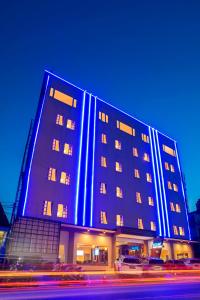 Zoom Hotel MulawarmanSamarinda
Zoom Hotel MulawarmanSamarinda Quest Hotel Balikpapan by ASTONBalikpapan
Quest Hotel Balikpapan by ASTONBalikpapan RedDoorz Syariah near Taman Bekapai 2Klandasan Kecil
RedDoorz Syariah near Taman Bekapai 2Klandasan Kecil Novotel BalikpapanBalikpapan
Novotel BalikpapanBalikpapan Reddoorz near Juwata Airport TarakanTarakan
Reddoorz near Juwata Airport TarakanTarakan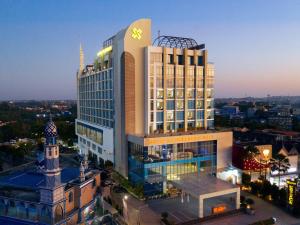 Platinum Hotel & Convention Hall BalikpapanBalikpapan
Platinum Hotel & Convention Hall BalikpapanBalikpapan
Looking for places related to East Kalimantan?
Those are other destinations to find places related to East Kalimantan:
